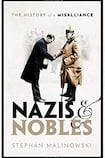
For the past few years a rather unusual restitution debate has been making waves in Germany. At the centre of the controversy is Georg Friedrich, Prince of Prussia, head of the House of Hohenzollern that ruled Imperial Germany until the last Kaiser, Wilhelm II, was forced to abdicate following the November Revolution in 1918.
While the Hohenzollern family was allowed to keep most of its considerable assets in 1918, its fortunes changed in 1945 when the Red Army conquered the eastern half of Germany and nationalised their lands, castles and possessions.
In 1990, following the end of the cold war and German reunification, the German parliament decided to offer compensation to individuals and families affected by East German nationalisation – with one important qualification: those who had actively supported the Nazi dictatorship would be disqualified from restitution. In the case of the Hohenzollern family, their legal claim to restitution hinges on the actions of Prince Georg’s great-grandfather (and son of Germany’s last Kaiser, Wilhelm II), Crown Prince Wilhelm, in the 1930s.
The complex question of the German aristocracy’s relationship with the Nazis is at the heart of Stephan Malinowski’s brilliant book, Nazis and Nobles, first published in German in 2003 and now available in a revised and updated English edition. The Edinburgh-based historian, who has been one of the most prominent voices in the Hohenzollern restitution debate, explores in great detail the role played by the nobility in German political life between 1918 and the consolidation of Nazi power in the 1930s.
As Malinowski shows, the German nobility was too weak to prevent the November Revolution that deprived them of their privileged access to high political offices and senior military careers. Instead of reconciling themselves with the new political realities, most German aristocrats remained deeply hostile to the Weimar Republic and played an active part in destabilising it, notably after 1929 when the Great Depression threw Germany into a deep economic and political crisis. Mostly conservative and nationalist in their political views, many German aristocrats believed they could instrumentalise the growing Nazi Party for their own political purposes.
In the German federal elections of summer 1932, the Nazis soared to 37 per cent of the vote, making them the biggest party in the Reichstag, though short of an overall majority. By this stage the Weimar Republic was already gravely weak, with power exercised largely by members of the conservative elite acting as advisers to the octogenarian president, Paul von Hindenburg. Rather than seeking to combat Nazism, they hoped to co-opt Hitler, often using the metaphor that they would be “riding the Nazi movement like a horse”.
Some of them, including Crown Prince Wilhelm of Prussia, hoped that Hitler would agree to a restoration of the monarchy in which Wilhelm would become a ceremonial head of state. A famous picture of the time shows the Crown Prince, dressed in a military uniform and sporting a Nazi armband, standing above a large swastika at a rally of 80,000 Nazi brownshirts.
The symbolic importance of the image cannot be underestimated, Malinowski argues. Through his public support for the Nazis, the heir apparent to the German throne lent much-needed legitimacy to Hitler and his movement. Wilhelm himself boasted that his support for the Nazis had won them two million extra votes.
Convincing case
In his deeply researched and well-written portrait of an aristocratic world that has since ceased to exist, Malinowski makes a convincing case that the German nobility, often primarily associated with resistance against Hitler in the form of Count Claus von Stauffenberg’s July 1944 bomb plot, actually played a central role in the destruction of Weimar democracy.
Even in 1940, when the Nazis were in the process of conquering western Europe, the former Kaiser, Wilhelm II, sent Hitler a congratulatory telegram from his exile in the Netherlands: “My Fuhrer, I congratulate you and I hope that under your marvellous leadership, the German monarchy will be restored completely.” Such hopes were futile. Hitler had no time for monarchists after 1933 – a realisation that would come too late for many aristocrats.
The German courts have yet to reach a decision about the Hohenzollern claim to restitution. In the meantime, Malinowski has provided the best available analysis of the political radicalisation of Germany’s nobility in the 1920s and their widespread support for the Nazis in the early 1930s.
It is unlikely that this book will please the House of Hohenzollern or those who subscribe to the myth that Germany’s nobility was immune to Nazism. But then again, the days in which historians wrote books to please kings and princes are fortunately long over.
Robert Gerwarth’s latest book, November 1918: The German Revolution, is published by Oxford University Press.








